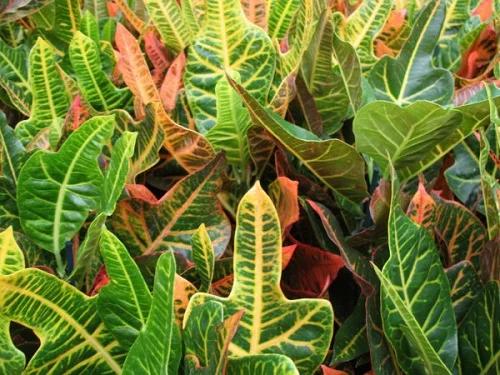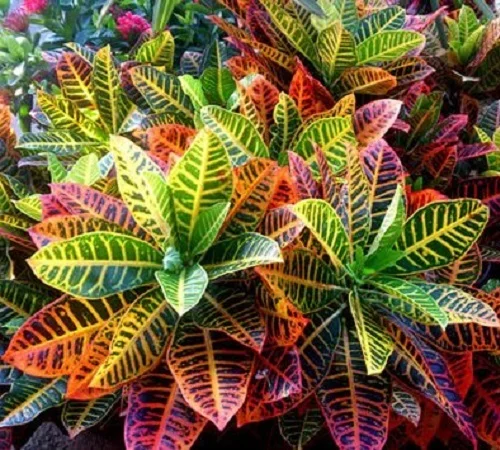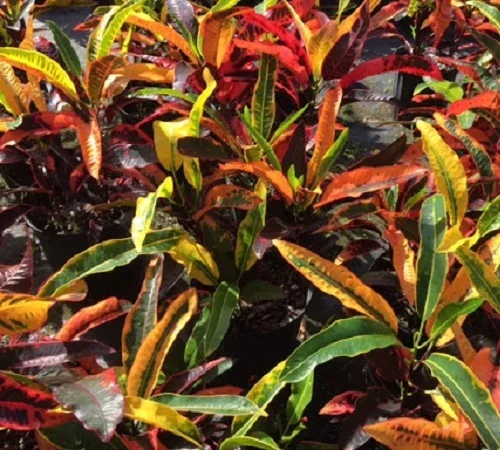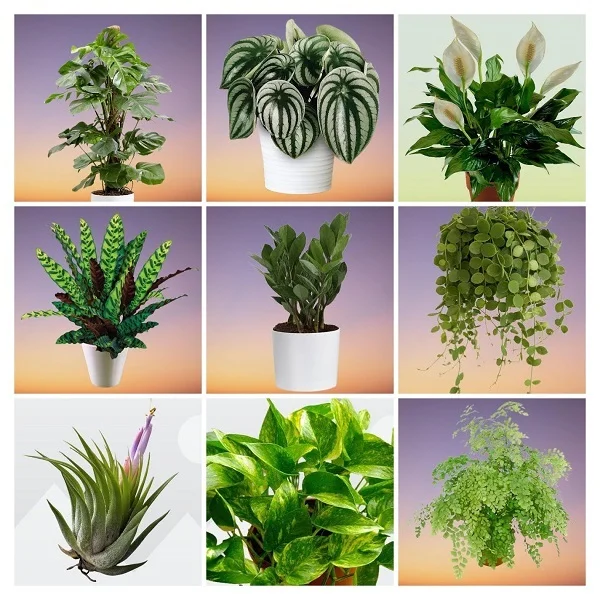Codiaeum variegatum (Croton Plants) Care Indoors, Common Problems & Remedies
Some links in this post may be affiliate links
Crotons (Codiaeum variegatum) require bright light with some sunlight, warm and humid conditions, and consistently moist, rich, well-drained soil coupled with fortnightly feeding in the growing season.
Codiaeum variegatum also called Joseph's Coat are some of the popular bold statement plants on account of their vivid foliage colors and varied leaf shapes. The large stiff leaves are borne on an upright stem where the usual pattern is large and lobed foliage on which are distinctly colored veins.
Crotons may not be easy to grow under room conditions due to their requirement for high humidity and bright light but if they are cared for appropriately, they make resilient and beautiful plants ideal for home decor.

Botanical name: Codiaeum variegatum
Family: Euphorbiaceae
Common name: Croton Plant, Joseph's Coat
Origin
Codiaeum variegatum are native to Indonesia, Malaysia, Australia and Western Pacific Ocean islands where they grow in open forests and scrub.
Size
Croton Plants are tropical, evergreen shrubs which can grow to a height of about 9 feet and bear large, thick, leathery and shiny leaves.
Varieties
The basic variety is Codiaeum variegatum and over the years different named types have appeared. Most varieties of Croton Plants have Laurel-like foliage, but there are also forked leaves, long ribbons, lobed leaves, twisted and curled types. Identification is not easy.
Popular varieties of Croton Plant include Norma with green leaves with red veins and splashes of yellow, Bravo with green leaves splashed with yellow, Reidii with green leaves splashed with red, aucubifolium among many others.
The lobed Croton varieties include Craigii and Holuffiana. Other common varieties are Gold finger, Gold star, Gold Moon, Mrs Iceton, Excellent among many others.
Are Codiaeum variegatum toxic?
Yes. As with many plants of the Euphorbiaceae family, Codiaeum variegatum produce a sap that can cause skin irritation and eczema in sensitive skin. The bark, roots, latex and leaves are poisonous. The sap contains the toxic chemical compound 5-deoxyingenol. Consumption of the plant's seed can be fatal to humans.
Where to Buy
Would you like to add Crotons to your plant collection? You may obtain these plants online from Etsy (Link to Etsy) or from Amazon (Link to Amazon).
How to Care for Codiaeum variegatum Indoors
To care for Codiaeum variegatum indoors, give it bright light with 4-6 hours of direct morning or late evening sunlight, warmth of 18-270C, humidity of 60-70% and consistently moist, rich, well-drained soil coupled with regular feeding during the growing season.
Crotons do not like too frequent repotting as they best when pot-bound. Regular pruning is necessary to keep the plants neat and tidy as well as promote compact and bushy growth. Keep reading for more on the growing conditions and how to achieve them.

Watering
How often should I water my Croton?
Water your Croton Plant liberally in spring and summer while allowing the top 1-2 inches of soil to dry out slightly between waterings. Keep the soil consistently moist but not soggy to avoid rotting, yellowing and leaf drop.
Cut down on watering in fall and winter to maintain the soil slightly moist as growth is reduced at this time. Never allow the soil to dry out completely to prevent wilting, yellowing and leaf loss.
Use water that is free of chlorine and other dissolved chemicals which can cause browning of leaf edges and tips. Only water with room temperature water to prevent cold shock as it can lead to stunted growth and loss of leaves./p>
Ensure that the pot has a drainage hole and the soil is well-draining to prevent waterlogging as it can result in root-rot which is characterized by yellowing of leaves followed by leaf fall.
Light Requirements
Do Crotons like sun or shade?
Croton Plants like bright light with 4-6 hours of direct morning or late evening sunlight to enhance the leaf colors. Keep the plants away from hot midday sunshine to avoid loss of leaf color.
If the light is too low, growth will slow down and the plant may begin to yellow and lose its leaves. Where the natural light is not sufficient, you may grow the plant under full spectrum grow lights to sustain a healthy growth.
Turn the pot regularly to ensure that the plant receives light on all sides for even growth and prevent lopsided growth.
Crotons can grow outdoors too. Avoid moving the plant to a new location before acclimating it as it can cause it to drop all its leaves. Move it gradually to a brighter spot every day over a period of 2 weeks.
On account of their requirement for bright light with some sunshine, Crotons are considered as some of the best sun-loving plants for a sunny location.
Temperature & Humidity
Codiaeum variegatum prefers an average warmth of 18-270C. Keep it away from drafts and don't expose them to low temperatures as the leaves may get brown edges or drop and the plant may die.
Crotons flourish in a humidity of 60-70%. Therefore, to increase humidity, set the pot on a wet pebble tray or use a cool mist humidifier.
You may also grow the plant in a well-lit bathroom or in a terrarium as a high humidity can be maintained inside a terrarium.
Fertilizer
Feed Croton Plant every 2 weeks in spring and summer with a balanced, liquid fertilizer to promote a lush growth. Withhold feeding in fall and winter as growth is minimal and feeding at this time can lead to fertilizer burn.
Leach out accumulated salts every 2-3 months by running a stream of water through the soil until the water comes out through the drainages holes.
Potting Soil
The best soil for Croton Plant should be rich in organic matter and free-draining to prevent it from getting soggy while providing the required nutrients. Most all purpose potting mixes are ideal for this plant. You may make your selection from these 16 potting mixes for indoor plants.
Repotting
Repot Croton Plant during the growing period only if the plants are overcrowded as they grow best when pot-bound. Carefully cut through the roots with a knife and pot the sections separately.
Use a pot one-size larger and free-draining soil that is rich in organic matter. Ensure the pot has a drainage hole to prevent the soil from getting soggy as it can lead to root-rot. Check out these pots with drainage holes on Amazon.
Replenish the top 2-3 inches of soil with fresh soil every few 2-3 years for the large plants. To control the plant keep it in the same pot, so that the roots are confined.
Pruning & Grooming
Pruning of Croton Plant involves removal of yellow and dead leaves to maintain the plant neat and tidy as well as minimize pest and disease infestations.
Codiaeum variegatum can become too large or leggy with age. Cutback the branches to the desired height to encourage fresh and vigorous growth for a more compact plant.
The best time to cutback is at the beginning of the growing season. Do not cut back the plant by more than one third. The foliage emanating from the cutting-back, may be used to propagate new plants.
Regularly clean the leaves by damp-wiping with a soft cloth to get rid of dust and discourage pest and disease infestations.
Codiaeum variegatum Propagation
Codiaeum variegatum (Crotons) are propagated from stem cuttings or by air layering in spring to early summer when it is in active growth. The stems cuttings can be rooted either in water or in soil.
Learn how to propagate Codiaeum variegatum (Crotons) by 3 easy methods.

Codiaeum variegatum Problems & Fixes
Codiaeum variegatum (Crotons) problems are leaf drop, yellow leaves, brown leaf tips & edges, loss of leaf color, pests and diseases among others. Keep reading for more on these problems and their remedies.
Leaf drop
Why do the leaves keep falling off my Croton Plant?
Your Croton Plant leaves keep falling off due to dry air, inconsistent watering, temperature stress, insufficient light, nutrients deficiency, aging or sudden change in growing conditions.
How to fix it
Dry air: Set the pot on a wet pebble tray, use a cool mist humidifier or group the plants together to elevate humidity.
Inconsistent watering: Do not water on a schedule. Water when the top 1-2 inches of soil dry out but never allow the soil-ball to dry out completely.
Temperature stress: Keep the plant away from sources of drafts like windy doors, drafty windows, AC units, hot air vents among others to maintain constantly warm temperatures.
Insufficient light: Position the plant in bright light with some direct sunlight or use a grow light if you do not have adequate light in your home.
Nutrients deficiency: Feed the plant with a balanced, water-soluble fertilizer every 2 weeks in spring and summer.
Aging: This is a natural process. As the lower leaves mature, they turn yellow, brown and eventually fall off.
Sudden change in growing conditions: Gradually acclimatize the plant to new growing conditions.
Yellow leaves
Some of the causes of yellow leaves on Codiaeum variegatum are too little light, soggy soil, underwatering, extreme temperatures, nutrients deficiency or aging.
How to fix it
Too little light: Position the plant in bright light with 6-8 hours of sunshine or use a grow light if you do not have sufficient light in your home.
Soggy soil: Use well-draining soil and a pot that has a drainage hole.
Underwatering: Water when the top 1-2 inches of soil dry out but do not allow the soil to dry out completely.
Extreme temperatures: Keep the plant away from sources of drafts like hot air vents, AC units, hot surfaces, windy doors and others.
Nutrients deficiency: Feed the plant fortnightly in spring and summer with a balanced, water-soluble fertilizer.
Aging: This is a natural process. As the lower leaves mature, they turn yellow and eventually die.
Brown leaf tips
Brown leaf tips on Croton Plant are caused by nutrients deficiency, dry air, inconsistent watering, or salts buildup.
How to fix it
Nutrients deficiency: Feed the plant every 2 weeks in spring and summer with a balanced, liquid fertilizer but do not feed in fall and winter.
Dry air: To raise humidity, set the pot on a wet pebble tray, use a cool mist humidifier or grow the plant in a well-lit bathroom, kitchen and other humid areas in the home.
Inconsistent watering: Do not water on a schedule. Water when the top 1-2 inches of soil feel dry to the touch and never allow the soil to dry out completely.
Salts buildup: Once in a while flush out accumulated salts from the soil by running a steady stream of water through the soil until it drains through the drainage hole.
Loss of leaf color
Loss of leaf color on Codiaeum variegatum is caused by too little light. Position the plant in a brighter spot where it will receive bright light with some direct morning or evening sunlight to enhance the beautiful leaf color. You may also grow the plant under a grow light if the natural lighting is not enough.
Pests
Common pests on Croton Plant are mealybugs and spider mites which are prevalent on weak plants and in dry, stuffy conditions.
How to fix it
- Isolate the affected plant to prevent spread to the rest of the plants.
- Treat the affected plant with neem oil or an insecticidal soap as per the manufacturers' recommendations.
- Regularly check underneath and between the leaves for these pests and carry out timely control measures.
- Keep the plant well pruned and raise humidity to depress the pest infestations.
Diseases
Codiaeum variegatum is prone to root-rot disease. This is a fungal disease that is prevalent in soggy soil due to poor soil drainage.
How to fix it
- Slip the plant out of its pot, wash off the soil and inspect the roots.
- Brown-black, mushy roots indicate root-rot; cut them away. In addition, cut away any stems showing any signs of rot.
- Disinfect the healthy roots and the entire plant with a copper-based fungicidal solution as recommended by the manufacturer.
- Disinfect the pot with the fungicidal solution or use a fresh pot to repot the plant in fresh potting soil.
- Ensure that the pot has a drainage hole and the soil is well-draining to prevent waterlogging.
- Water the plant with the fungicidal solution and place it in a warm, brightly-lit spot.
- Do not water the plant again until new growth appears and avoid overwatering and soggy soil thereafter.
You liked it? Share on social media.
Related Content
Amazon Associates Disclosure
Homeplantsguide.com is a participant in the Amazon Services LLC Associates Program, an affiliate advertising program designed to provide a means for sites to earn advertising fees by advertising and linking to amazon.com.





